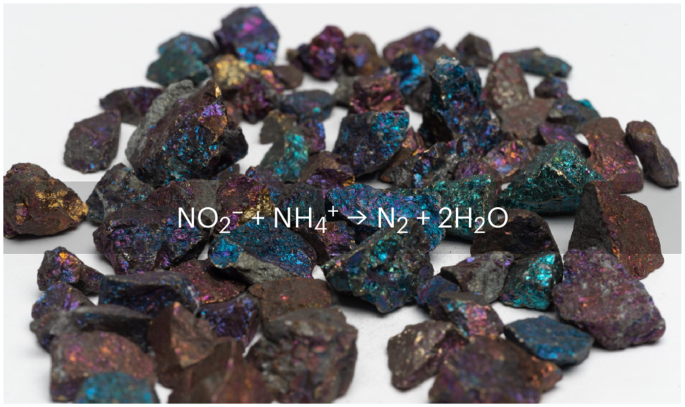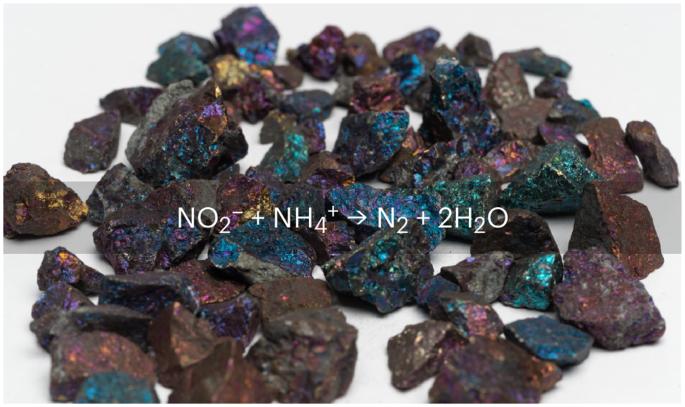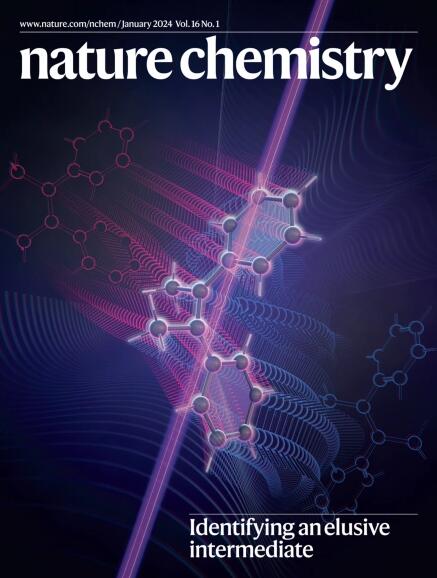硫化铜矿物通过肼中间体进行非酶促厌氧氨氧化作用
IF 20.2
1区 化学
Q1 CHEMISTRY, MULTIDISCIPLINARY
引用次数: 0
摘要
厌氧氨氧化(anammox)--用亚硝酸盐激活氨的生物过程--是海洋环境中产生大量 N2 的原因。然而,尽管进行了数十年的生物化学研究,仍未发现能够进行厌氧氧化的合成模型。在这里,我们报告了一种硫化铜矿物复制了由三种金属酶催化的整个生物氨氧化途径。我们发现了一种由亚硝酸盐还原形成的铜-亚硝基锍{CuNO}10复合物,它是氨氧化的氧化剂,导致亚硝酸盐和氨形成异解N-N键。与生物过程类似,N2 的产生是由高活性中间体肼(自然界中最有效的还原剂之一)介导的。我们还发现了另一种涉及 N-N 键异偶联的途径,用于形成混合 N2O,这是一种具有独特同位素组成的强效温室气体。我们的研究是一个罕见的非酶氨氧化反应实例,它将非生物氮循环中的六种氧化还原状态相互联系起来。本文章由计算机程序翻译,如有差异,请以英文原文为准。


Copper sulfide mineral performs non-enzymatic anaerobic ammonium oxidation through a hydrazine intermediate
Anaerobic ammonium oxidation (anammox)—the biological process that activates ammonium with nitrite—is responsible for a significant fraction of N2 production in marine environments. Despite decades of biochemical research, however, no synthetic models capable of anammox have been identified. Here we report that a copper sulfide mineral replicates the entire biological anammox pathway catalysed by three metalloenzymes. We identified a copper–nitrosonium {CuNO}10 complex, formed by nitrite reduction, as the oxidant for ammonium oxidation that leads to heterolytic N–N bond formation from nitrite and ammonium. Similar to the biological process, N2 production was mediated by the highly reactive intermediate hydrazine, one of the most potent reductants in nature. We also found another pathway involving N–N bond heterocoupling for the formation of hybrid N2O, a potent greenhouse gas with a unique isotope composition. Our study represents a rare example of non-enzymatic anammox reaction that interconnects six redox states in the abiotic nitrogen cycle. The discovery of anaerobic ammonium oxidation, termed anammox, has changed views on ammonium activation in biology, but no synthetic models of this reaction have been identified. Now biological anammox, catalysed by three metalloenzymes, is shown to be replicable by a single copper sulfide mineral.
求助全文
通过发布文献求助,成功后即可免费获取论文全文。
去求助
来源期刊

Nature chemistry
化学-化学综合
CiteScore
29.60
自引率
1.40%
发文量
226
审稿时长
1.7 months
期刊介绍:
Nature Chemistry is a monthly journal that publishes groundbreaking and significant research in all areas of chemistry. It covers traditional subjects such as analytical, inorganic, organic, and physical chemistry, as well as a wide range of other topics including catalysis, computational and theoretical chemistry, and environmental chemistry.
The journal also features interdisciplinary research at the interface of chemistry with biology, materials science, nanotechnology, and physics. Manuscripts detailing such multidisciplinary work are encouraged, as long as the central theme pertains to chemistry.
Aside from primary research, Nature Chemistry publishes review articles, news and views, research highlights from other journals, commentaries, book reviews, correspondence, and analysis of the broader chemical landscape. It also addresses crucial issues related to education, funding, policy, intellectual property, and the societal impact of chemistry.
Nature Chemistry is dedicated to ensuring the highest standards of original research through a fair and rigorous review process. It offers authors maximum visibility for their papers, access to a broad readership, exceptional copy editing and production standards, rapid publication, and independence from academic societies and other vested interests.
Overall, Nature Chemistry aims to be the authoritative voice of the global chemical community.
 求助内容:
求助内容: 应助结果提醒方式:
应助结果提醒方式:


